The Final Curtain For The Cinedome |
Read more
at in70mm.com The 70mm Newsletter |
| Written by: Bill Kallay | |
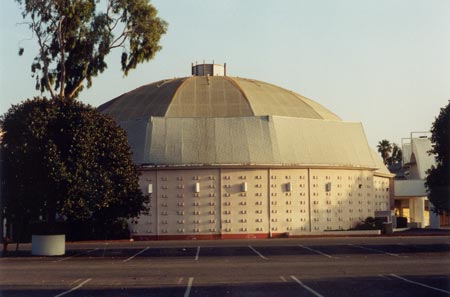 One
of the domes which featured 863 seats. Picture by Bill Kallay. One
of the domes which featured 863 seats. Picture by Bill Kallay.The inevitable coming of bulldozers happened this April when the Orange Cinedome [Los Angeles, USA] was demolished. The once grand theater, which opened in 1969, was a victim of the current craze of megaplexes across America. Time was kind to the theater, until its owner, Century Theaters, closed it in favor of an elaborate behemoth down the road called the Century 25 Stadium Theaters. Going to the movies will not be the same in Orange County, California. |
Further
in 70mm reading: 70mm Movie Theatres in Southern California 70mm films in Los Angeles Internet link: Pictures have been copied here with permission |
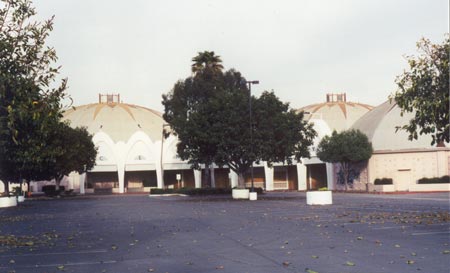 Part
of the Cinedome complex and box office, one week after closure. Picture
by Bill Kallay. Part
of the Cinedome complex and box office, one week after closure. Picture
by Bill Kallay.The theater was unique in that its two main auditoriums were large domes, featuring 863 seats each and large curved screens. Over the course of thirty years, it was not uncommon to see 70mm films shown in them. What is somewhat humorous is that those theaters also had stadium seating from opening day until its closure in early 1999. Isn't the craze now called "stadium seating?" |
|
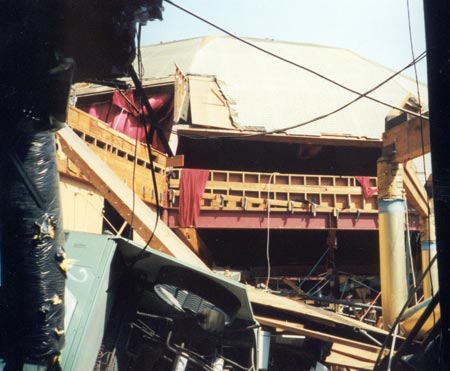 A
view from the former lobby. Picture by Bill Kallay. A
view from the former lobby. Picture by Bill Kallay.The theater expanded on a periodic basis over the years, eventually going from 2 theaters to eleven by 1992. The complex itself was consistently renovated and upgraded. In the early 1970s, the large domes featured early 70mm films such as "Camelot" and an exclusive Quintaphonic Sound presentation of "Tommy" in 1975. By the late '70s, Cinedome featured 70mm Six Track Dolby Stereo and Dolby Stereo in most of its auditoriums. During the 1980s, Cinedome was the theater to see films presented in 70mm. On certain summer periods, the theater would run four 70mm prints of different movies at the same time. The two large domes, a 500-plus seat standard auditorium and a smaller dome were large gauge equipped. |
|
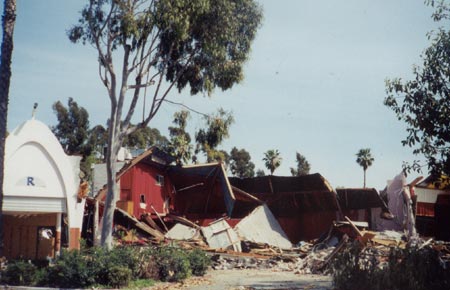 The
small dome, left, after the buldozer.
Picture by Bill Kallay. The
small dome, left, after the buldozer.
Picture by Bill Kallay.More than likely if a film had a 70mm print available, the Cinedome acquired it. During the initial re-lease of "Return of the Jedi", two 70mm prints were run. The domes were very popular with filmgoers, well before the stadium seat craze took over the nation. Patrons enjoyed the unhampered sightlines and the curved screens. The layout of the domes, much like a curved amphitheater, was spacious and luxurious. Plush curtains and entry music greeted movie goers, at least until slide shows took over the pre-movie screen. Though the Cindedome wasn't perfect, it was a theater one remembered even if the film was bad. The floors in the domes were hollow, so walking on them was like walking on a wooden box. Going to the bathrooms was always an interesting experience. Few theaters I've encountered allowed me to do my business and still hear the loud movie soundtrack in the dome above me. And Cinedome prided itself on pre-popped popcorn. But Cinedome was a modern movie palace. Sitting in the domes, one was always comfortable due the rocking chairs the theater had. The dome's ceiling seemed like it went on into infinity. And the presentation Cinedome was a treat. Even on 35mm stereo releases, the theater would always rock. But it was on 70mm presentation that Cinedome was legend. In "Raiders of the Lost Ark", the boulder rumbled over your head. In "Ghostbusters", Slimer floated through your chest and back into the large surround speaker behind you. In "True Lies", you felt the bullet casings falling on the bathroom floor in Arnold's in-famous fight. |
|
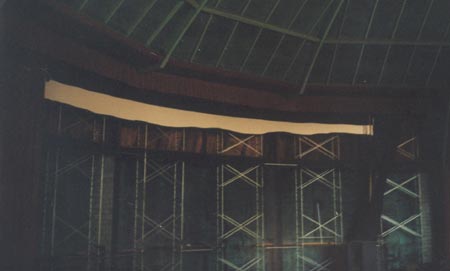 Interior
of one of the large domes, minus screen.
Picture by Bill Kallay. Interior
of one of the large domes, minus screen.
Picture by Bill Kallay.The theater was very profitable and consistently busy, even during the week. Why Century chose to shutter the theater rather than expand it baffles fans of the theater (there are many), but perhaps made sense for the company. There was room on the property to expand and build a parking structure (parking was never a strong suit at Cinedome). They instead chose to build a 25-screen complex on the site of an old drive-in. Add to that restaurants and shops next to it, Century made both a jump into 21st century megaplexing and added profits. The new theater is popular, but lacks the features of Cinedome. Most of the theaters are small and the screens are fitted for 1.85:1 aspect ratios. There are constant sellouts, despite popular films being shown on multiple screens. Cinedome didn't have that problem most of the time. As the bulldozers tore out the projection booths, the domes became nothing more than covered amphitheaters. The screens were indiscriminately ripped to shreds. The speaker stands that once held the huge speakers became jagged towers of steel. The fairly new plush red seats were covered with dust and roofing tiles. Orange County is a place where any building over thirty years old is demolished. Cinedome fell right in line with that tradition. It's reminiscent of the film "Logan's Run" where no one was supposed to live over the age of 30. |
|
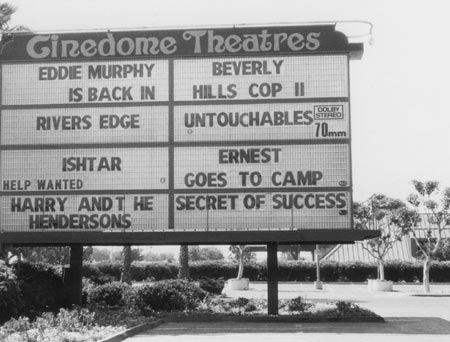 The
marquee during the summer of 1987. Picture by Bill Kallay. The
marquee during the summer of 1987. Picture by Bill Kallay.When the theater closed, some patrons came to the theater in disbelief that it was closed. Others quipped that it was rundown and in a bad location. That wasn't true. It was in good shape, equipped with Dolby Digital, DTS and SDDS sound. The location was perfect, for it sat between two freeways. In fact, Interstate 5 allowed patrons to exit right at the entrance to the Cinedome parking lot. Time hasn't been kind to 70mm or the theaters it played in. All over Southern California, theaters equipped for 70mm have been closed in favor of megaplexes. This has occurred in rapid succession in less than five years. Exhibition chains favor catering to the masses, which is fine. But they've also created an atmosphere where there is a sameness to going to the movies. Cinedome and theaters like it were always one step above the norm. |
|
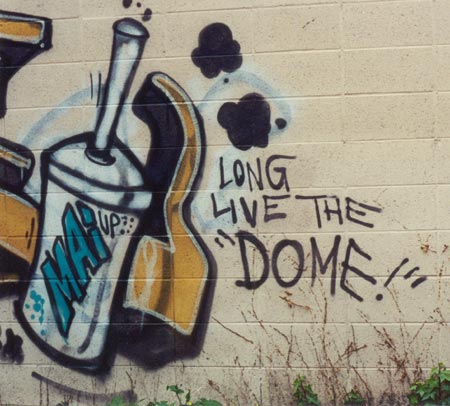 Though
in agreement, the author did not write this. Picture by Bill Kallay. Though
in agreement, the author did not write this. Picture by Bill Kallay.The Cinedome will be missed by movie fans, especially 70mm fans. The feeling is akin to being a baseball fan who attends a classic ballpark, only to see if torn down in favor of a modern stadium. Fortunately, there are Cinedomes located in Northern California. But then again, maybe they'll meet the same fate as the Orange Cinedome. The Cinedome had the distinction of first class presentation, great picture and the latest sound systems available. |
|
|
Go: back
- top - back issues
- news index Updated 22-01-25 |
|
